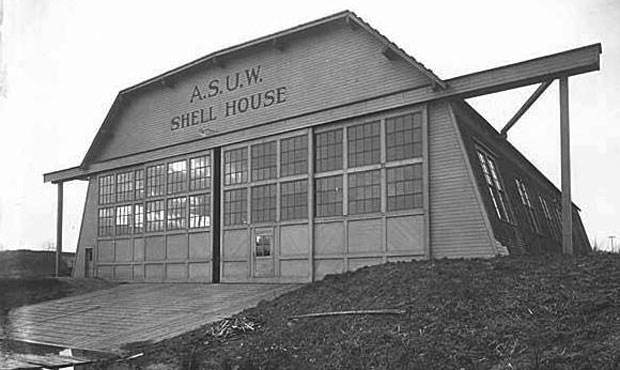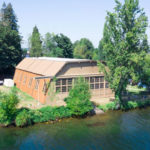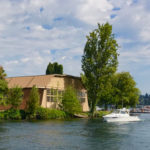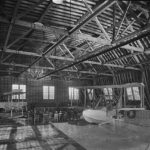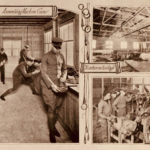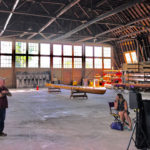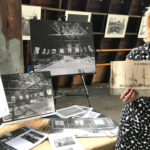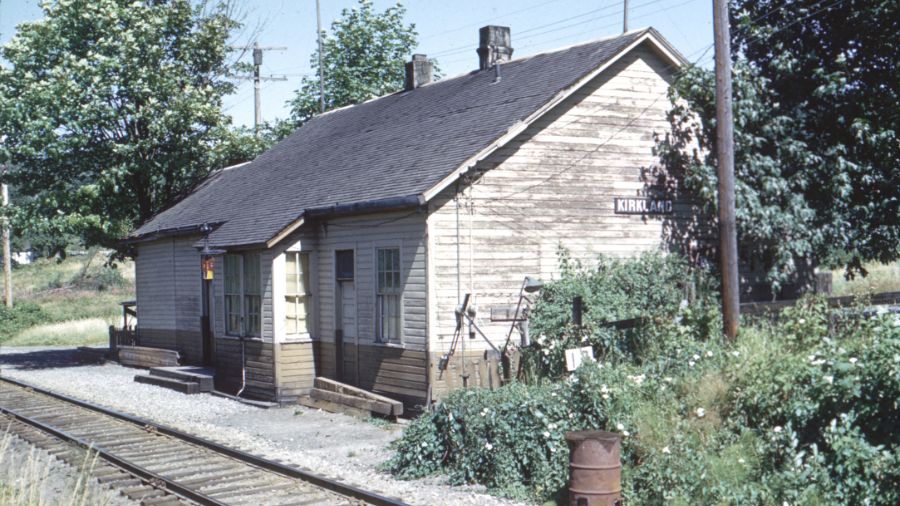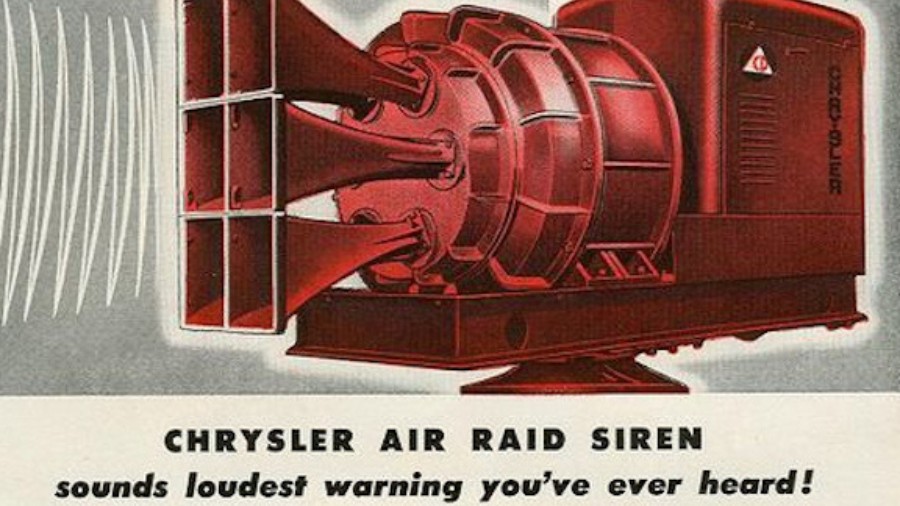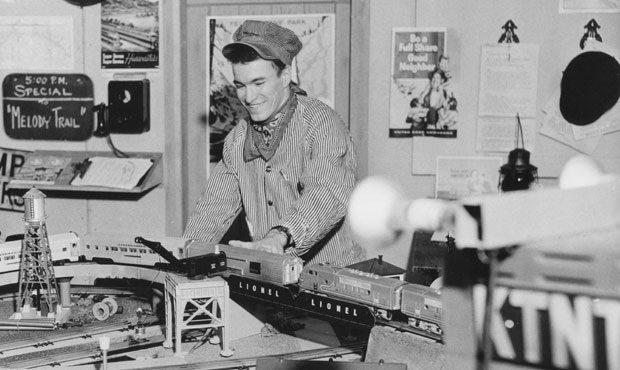Saving the home of ‘Boys in the Boat’ and men in the ships
Dec 20, 2023, 7:30 AM | Updated: 9:40 am
It was built more than a century ago to train seaplane pilots as America entered World War I. Then, it was home to the “Boys in the Boat,” who captured Olympic Gold in the 1936 summer games in Berlin.
You know this building if you’ve ever traveled by boat through the Montlake Cut, or if you’ve walked the trails near the Arboretum just north of the site of the old MOHAI next to the 520 Bridge.
“We’re sitting in a 10,000 square foot, Douglas fir-built, wooden hangar, built 101 years ago by the Navy,” said the UW’s Nicole Klein, after leading a tour through the 1918 structure. Klein is staffing an effort to raise money to restore the historic building and open it to the public as a combined event space and museum.
“And we’re surrounded by old Pocock wooden racing shells and training wherries, some canoes, and the great big hangar doors that span and look out to the Montlake Cut,” Klein continued, sweeping her hand around and across the original concrete that covers the giant open floor plan of the distinctive space.
Seattle’s Japanese-American war hero who died on the 4th of July
“Pocock” is George Pocock, who for years built racing shells in a second floor workshop at the back of the old building.
The vintage seaplane hangar is, indeed, a remarkable piece of wooden architecture unlike anything else around Seattle, or just about anyplace else. Douglas fir-construction means it’s literally made of history, and what took place here over the early decades in particular means it’s filled with history.
“We’re restoring this building because it’s an important landmark for both the UW and our state and our country,” Klein said. “It’s served for the last 100 years in different roles. And we need to celebrate our connection with water and all these layers of history.”
The Boys in the Boat
Klein, who clearly relishes her role leading the project as much as she loves the old hangar itself, says out-of-town tourists routinely knock on the door of the old building, asking to be let in to see where the “Boys” trained.
Those gold medalists were Huskies, and their story is emblematic of the city and the region, Klein says, and it’s a story worth telling again and again.
“That would be forgotten if we weren’t allowing the public and our students to come back in and see it for themselves,” Klein said. “And I think it’s our duty as the campus to preserve this history, and make sure that people can see it.”
The University of Washington has owned and managed the hangar since not long after the Armistice that ended World War I. From 1919 to 1950, this was the place where the UW men’s rowing team trained, including those young Huskies who went to Hitler’s Berlin and won the gold medal that ultimately spawned the Boys in the Boat book that’s grown into a cultural phenomenon.
Generations of regular recreational rowers called the old building “home,” too. After the rowing team moved to a new boathouse in 1950, the hangar became the “A.S.U.W. Shell House” (aka “the Canoe House”). Students and others could rent boats there and paddle out into the Arboretum until the rentals were moved to a nearby building in 1975.
It was almost torn down in the early 1970s, but demolition was averted and it was added to the National Register of Historic Places in 1975. After serving as home to the sailing team (which led to a few more gold medals), the hangar has mostly been used for storage for the past several years. Now, the UW is about to embark on a fundraising effort to restore it, and operate the building as a combined event space and museum.
Aviation history
Klein is in charge of a campaign to raise a total of $13 million, including $10 million in capital improvements and a $3 million endowment. The campaign is currently in the so-called “quiet phase,” as potential donors are cultivated and major gifts are solicited behind-the-scenes in order to reach the halfway point of the fundraising goal. Once that happens, a broader public campaign will be launched.
Apart from its “Boys in the Boat” fame, the hangar is likely the only remaining part of what, for a brief time, was a sprawling “US Naval Training Station” that operated for less than two years on the UW campus.
“In 1917, the Navy established a training camp here for the naval militia [a sea-based version of the National Guard] of Oregon and Washington,” said Lee Corbin, a retired military pilot who’s serving as volunteer aviation historian for the hangar project.
The training station comprised an assortment of dormitories, sheds, houses and purpose-built structures that sprawled from where Husky Stadium now stands, and stretched south and west along the north side of the Montlake Cut. This was several years before the Montlake Bridge was built, and was less than a year after the Montlake Cut and Ballard Locks and the entire Lake Washington Ship Canal had opened, allowing marine traffic from saltwater Puget Sound to reach freshwater Lake Union and Lake Washington.
Corbin says that there were as many as 5,000 sailors stationed at the UW at a time, and about 10,000 total were trained there during the two years the Naval facility was in existence. And it was some of those men, when the Spanish Flu pandemic struck Seattle in 1918, who were among the first to be diagnosed here and quarantined.
Aviation training at the UW, and construction of the hangar, came a year or so into the short life of the training station.
On D-Day, West Coast radio listeners ‘sat up all night by the radio’
“In the early months of 1918, it was decided that an aviation detachment should also be placed here,” Corbin said. “The aviation facility here was actually one of three in the United States that served as Naval ‘ground schools’ [for pilots-in-training]. There was one at MIT back in Boston, there was one in Minneapolis, and then the UW was the third one.”
Old photos of the interior of the hangar from World War I show seaplanes of that era and men taking part in training activities. Corbin has identified the makes and models of aircraft, and tracked the histories of several that appear in the old photos.
“They strictly did pre-flight training” at the UW, says Corbin. “You would come here to learn how to set up an airplane, how to taxi an airplane on water, but you wouldn’t actually do any flying here.”
Once the Armistice came and World War I was over, that was it for the training station, too.
“As soon as the war was over, they basically shut it down as fast as they could,” Corbin said. “They sent out thousands of guys that eventually did serve in the Navy, but as soon as the war was over, they tried to get guys out as quickly as possible.”
While the training center was shutdown quickly, some of the old Navy buildings were still in use as dorms and for other miscellaneous purposes as recently as the 1970s. Corbin thinks at least one old Naval structure was still standing just east of 15th Avenue NE until the last year or so.
With the war over and the training station closed, the seaplane hangar, with its location adjacent to Montlake Cut, was in the perfect spot to be repurposed as a boathouse for the rowing team.
Seize the moment
The way Nicole Klein see things, it’s that rowing team that just might be what ultimately saves the old hangar.
Klein sees the Boys in the Boat book as something of a catalyst. After the book came a PBS documentary. Now there’s a Boys in the Boat Hollywood film in the works. Klein says the movie has the potential to be the biggest thing to happen to our town, cinematically speaking, since Sleepless in Seattle.
“It’s going to tell the story that is this complete underdog, amazing story,” Klein said. “But also [a story] about that Greatest Generation, which I think we all need to hear right now.”
Saving Washington’s heritage barns cuts across political divides
Like a gold-medal rowing team, timing is everything for the old hangar, she says.
“We need to be ahead of that movie,” Klein said. “So when the movie hits and the masses come, we tell our story the way we want it to be told, and not just be sitting back on our heels going, ‘Oh, yeah. Wait, that’s their boathouse. We probably should’ve fixed that up for people to come inside and be safe.’”
“That’s another urgency that this building has,” Klein said. “It will have a role in telling who we are.”
Click here for more information about the campaign to restore the old seaplane hangar.
Originally published: September 11, 2019
You can hear Feliks every Wednesday and Friday morning on Seattle’s Morning News with Dave Ross and Colleen O’Brien, read more from him here, and subscribe to The Resident Historian Podcast here. If you have a story idea, please email Feliks here.

